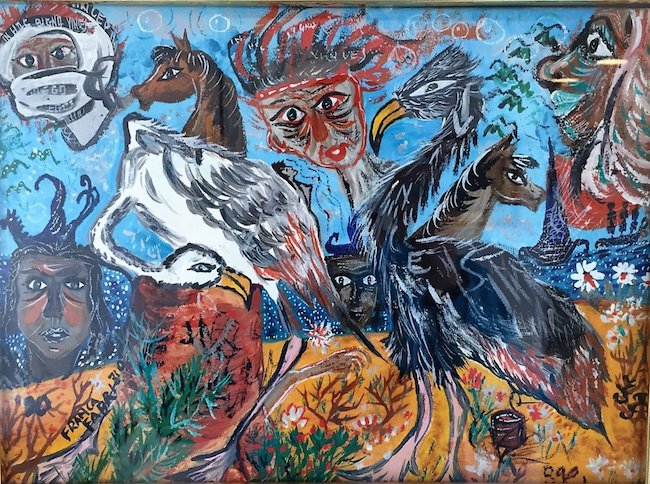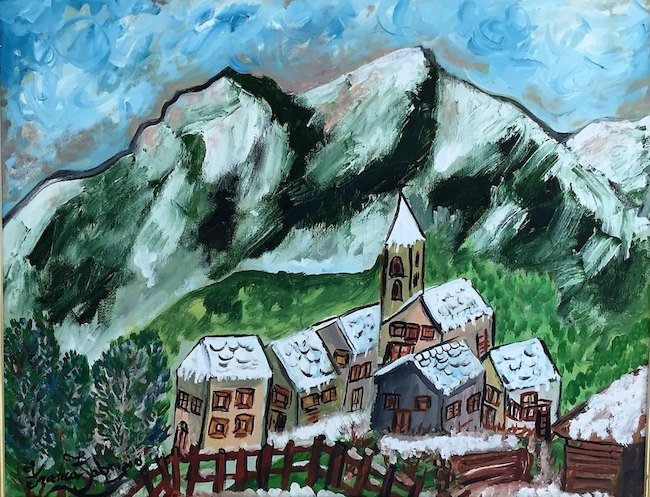La ricerca di un luogo ideale attraverso il quale riuscire a trovare una dimensione differente da quella contingente e osservabile nella quotidianità, che spesso appare troppo piatta o poco affine a un animo sensibile e orientato invece a lasciarsi trasportare dalla propria fantasia, è una caratteristica comune a tutti quegli artisti che preferiscono costruire qualcosa di nuovo e diverso, un universo parallelo in virtù del quale evadere dalla realtà oppure dare una propria personale interpretazione di tutto ciò che ruota intorno all’essere umano o alla vita dell’esecutore dell’opera. L’artista di cui vi racconterò oggi si immerge nel proprio mondo fatto di energie, di personalizzazioni dell’osservato e di mondi apparentemente irreali che racconta attraverso uno stile fortemente personale e riconoscibile.
Nel corso della storia dell’arte vi sono stati diversi grandi maestri che, ancor prima di appartenere a uno stile ben distinto e definito, hanno scelto autonomamente di legarsi a quelle energie sottili che interagivano con l’uomo, con le sue fantasie, i suoi sogni che pertanto apparivano enigmatici e inspiegabili; oppure, di contro, ve ne sono stati altri che si aggrappavano letteralmente a quel mondo fantastico per circondarsi di tutta quella leggerezza che non trovavano invece nella quotidianità. Uno dei pionieri del Simbolismo fu il pittore olandese Hieronymus Bosch i cui dipinti erano immersi in atmosfere inquietanti e pieni di figure e di scene allegoriche dei peccati e delle debolezze umane in cui l’apparato prospettico e le proporzioni sulla tela erano appiattite per dare maggior rilevanza e spazio ai numerosi elementi simbolici inseriti nella composizione pittorica; nel suo caso la riflessione su tutto ciò che concernesse l’uomo sembrava più orientata al mondo dell’incubo, alla visione cristiana della punizione a causa della dissolutezza e del peccato. Qualche secolo dopo non solo il Simbolismo divenne un vero e proprio movimento pittorico ma esaltò la connessione con una spiritualità troppo spesso dimenticata dagli artisti dei secoli precedenti, un legame con la natura e con il divino che induceva gli appartenenti alla corrente a soggettivizzare la realtà imprimendo sulla tela le proprie sensazioni, il sentire che proprio dall’osservato veniva ricevuto. Ci volle però ancora qualche anno prima che i creativi fossero in grado di appropriarsi completamente delle proprie emozioni, della loro sfera interiore, che fosse onirico o semplicemente emotivo poco importava, trovando così un modo completamente inedito di interfacciarsi con la tela, rinunciando al bello, alla perfezione esecutiva, al gusto estetico più accademico; quella nuova corrente prese il nome di Espressionismo e liberò completamente gli artisti da ogni regola stilistica precedentemente ritenuta fondamentale, rinunciando alla gamma cromatica affine alla realtà per dar spazio a una tavolozza che fosse in grado di accordarsi invece a quel mondo intimo, a quelle inquietudini oppure a quelle emozioni che necessitavano una propria dimensione diversa da quella reale. Tra i molti esponenti del nuovo stile che scelsero di evadere dalla contingenza per dare spazio al sogno, quello leggero, quello positivo e in grado di rendere più gioiosa e meno monotona la quotidianità vi fu il grande Marc Chagall che con le sue atmosfere oniriche e fantastiche pur non essendo mai completamente staccate dalla realtà, continua a far sognare collezionisti e appassionati di tutto il mondo. Per lui volare faceva parte di una dimensione quasi normale, immaginare un mondo idilliaco e sereno costituiva un progetto da realizzare, un desiderio all’interno del quale vivere attraverso le sue immortali opere.

L’artista Franca Fabrizio, nata in Umbria ma valdostana di adozione, sceglie di rimanere nella medesima dimensione immaginaria di Marc Chagall, riprendendone le atmosfere fiabesche all’interno delle quali colloca personaggi, oggetti, animali che sembrano avere una vita propria grazie all’ascolto delle energie sottili, della naturalità, che costituiscono le linee guida essenziali e imprescindibili della sua pittura quanto del suo approccio alla vita.

Il suo Espressionismo si mescola così al Simbolismo e all’attitudine di Bosch di riempire tutta la tela con i suoi protagonisti e le sue allegorie come se fossero tutti disposti in un unico piano, ma anche alla tendenza Naïf di semplificare la descrizione dei paesaggi e di tutto ciò su cui lo sguardo della Fabrizio si posa, dando vita a uno stile in cui il tratto del segno grafico emerge e si mescola con la parte pittorica, un approccio esecutivo che predilige la semplicità e l’immediatezza, quasi come se la realizzazione dell’opera fosse frutto di un sentire istintivo e come tale deve manifestarsi e fuoriuscire.
Racconta di un mondo fatto di emozioni belle, di musicalità, di paesaggi incontaminati, di animali che sembrano avere una propria spiccata personalità grazie alla capacità di Franca Fabrizio di ascoltarne le voci silenziose, quei piccoli dettagli, quegli inconsapevoli atteggiamenti che li contraddistinguono e che sono visibili solo a chi ha una particolare sensibilità.

Nell’opera Inter sidera versor (Mi muovo tra le stelle), l’artista racconta di un mondo in perfetta armonia tra uomo, animali, simboli tribali e antichi, case, tutto in un equilibrio in cui nessun elemento prevale sull’altro perché in fondo quando ci si sposta in una dimensione diversa, parallela e ideale, l’attaccamento alle priorità dell’esistenza terrena sembrano perdere importanza mentre emergono invece quelle più emozionali, quelle che danno vita a una scala di valori completamente differente, in cui il passato convive con il presente come se fossero in parallelo, entrambi indispensabili alla vita, in cui non esistono differenze di ruolo sociale, di razza o di religione, o dove i beni materiali, come una casa, non sono prevalenti sugli affetti di cui l’essere umano vive e si arricchisce. I vari elementi sono infatti posti sull’opera in modo disordinato proprio per sottolineare una scala di valori completamente sovvertita rispetto a quella dell’approccio razionale.
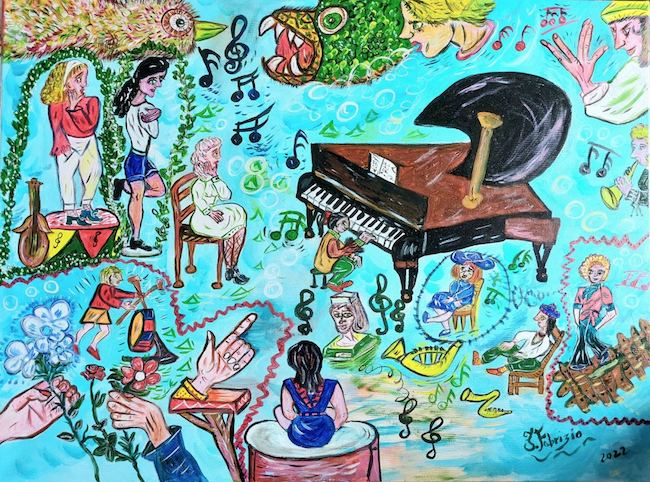
E ancora in Spiritelli della musica la Fabrizio mette in risalto non solo l’importanza dell’armonia delle note nella vita e nella storia dell’umanità bensì anche la connessione con tutto ciò che entra in sintonia con la melodia come la natura stessa, che ne giova, come le persone che si lasciano andare a sensazioni, a movimenti fluidi lasciando indietro le preoccupazioni della quotidianità anche solo per un attimo; rappresentare le note musicali vicine a quei piccoli folletti che sembrano aggirarsi intorno all’essere umano, come se si ponessero sopra la scia del flusso musicale ma anche energetico che nell’Universo costantemente si muove, diviene dunque un modo per lasciar intendere quanto vi sia oltre l’apparenza, quanto a volte, malgrado l’inconsapevolezza delle persone, tutto abbia una vita propria che prescinde dalla tendenza al controllo, quanto tutto abbia un senso differente da quello che l’uomo è abituato ad attribuirgli.
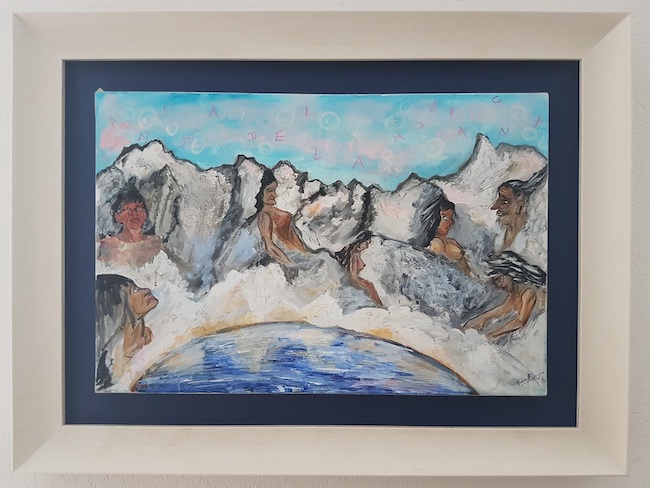
Nella tela L’anima della Montagna l’artista evidenzia quanto sia forte la sua attitudine ad andare oltre il visibile, a lasciarsi trasportare verso l’ascolto di tutto ciò che sembrerebbe destinato a non fuoriuscire ma che invece può manifestarsi se chi vi è davanti mostra una connessione profonda con un mondo più sotterraneo e al tempo stesso più elevato, più in armonia con il mondo in cui vive; tra le cime delle montagne raffigurate si nascondono infatti delle fate, delle giovani ultraterrene che mostrano all’osservatore quanto persino qualcosa di apparentemente inanimato come un monte possa avere un’anima, una capacità di assorbire l’atmosfera circostante, l’azione dell’uomo. Dunque in qualche modo nel suo sogno di un mondo migliore Franca Fabrizio attribuisce alle impervie montagne anche una capacità salvifica, l’umanità di aiutare e accogliere chi sa amare la natura ed è capace di prendersene cura, perdendo così quell’aspetto algido e distaccato per assumere un’apparenza più morbida, più in armonia con le debolezze e le fragilità dell’uomo.
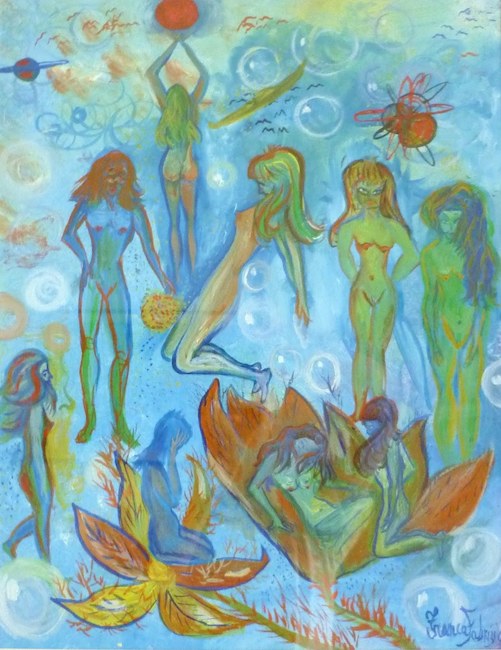
Franca Fabrizio non parte mai dal disegno bensì comincia a lavorare sulla tela in maniera impulsiva e inconsapevole, senza un progetto in mente perché poi sono la fantasia, l’immaginazione, a dare un senso compiuto a ciò che lascia fluire liberamente connettendosi con il suo ricco mondo fiabesco. Franca Fabrizio ha al suo attivo sette mostre personali e numerose partecipazioni a mostre collettive in Italia e all’estero, oltre ad aver preso parte a importanti fiere del settore come Paratissima nel 2015 e PaviArt nel 2022.
FRANCA FABRIZIO-CONTATTI
Email: fabriziofranca08@gmail.com
Sito web: https://www.pitturiamo.com/it/pittore-contemporaneo/franca-fabrizio-25803.html
Facebook: https://www.facebook.com/profile.php?id=1587832301
Instagram: https://www.instagram.com/franca4700/
The world of dreams and imagination in Franca Fabrizio’s Symbolic Expressionism
The search for an ideal place through which to find a different dimension from the contingent and observable dimension of everyday life, that often seems too flat or unsuited to a sensitive soul that is instead oriented towards letting itself be carried away by its imagination, is a characteristic common to all those artists who prefer to build something new and different, a parallel universe by virtue of which they can escape from reality or give their own personal interpretation of everything that revolves around the human being or the life of the artwork’s creator. The artist I am going to tell you about today immerses herself in her own world made up of energies, personalisations of the observed and apparently unreal worlds that she tells through a highly personal and recognisable style.
In the course of the history of art, there have been several great masters who, even before belonging to a distinct and defined style, have autonomously chosen to bind themselves to those subtle energies that interacted with man, with his fantasies, his dreams that therefore appeared enigmatic and inexplicable; or, on the other hand, there have been others who literally clung to that fantastic world to surround themselves with all that lightness that they could not find in everyday life. One of the pioneers of Symbolism was the Dutch painter Hieronymus Bosch, whose paintings were immersed in disturbing atmospheres and filled with figures and allegorical scenes of human sins and weaknesses in which the perspective apparatus and proportions on the canvas were flattened to give greater relevance and space to the numerous symbolic elements included in the pictorial composition; in his case, the reflection on everything concerning man seemed more oriented towards the world of nightmare, towards the Christian vision of punishment for debauchery and sin. A few centuries later, Symbolism not only became a true pictorial movement but also exalted the connection with a spirituality too often forgotten by the artists of previous centuries, a link with nature and the divine that induced the members of the current to subjectivize reality by impressing on the canvas their own sensations, the feeling that was received from the observed. However, it took a few more years before the creatives were able to completely appropriate their emotions, their inner sphere, whether oneiric or simply emotional was not important, thus finding a completely new way of interfacing with the canvas, renouncing beauty, executive perfection and the most academic aesthetic taste; this new current took the name of Expressionism and completely freed the artists from any stylistic rules previously considered fundamental, renouncing the range of colours associated with reality to make room for a palette that was capable of tuning in instead to that intimate world, to those anxieties or emotions that needed their own dimension different from the real one.
Among the many exponents of the new artistic style who chose to escape from contingency to give space to the dream, the light, positive one that can make everyday life more joyful and less monotonous was the great Marc Chagall, who with his dreamlike and fantastic atmospheres, although never completely detached from reality, continues to make collectors and enthusiasts all over the world dream. For him flying was part of an almost normal dimension, imagining an idyllic and serene world was a project to be realised, a desire within which to live through his immortal artworks. The artist Franca Fabrizio, originally born Umbria but now living in Valle d’Aosta, chooses to remain in the same imaginary dimension as Marc Chagall, taking up his fairy-tale atmospheres within which she places characters, objects and animals that seem to have a life of their own thanks to her listening to the subtle energies and naturalness that constitute the essential and unavoidable guidelines of her painting and her approach to life. Her Expressionism thus mixes with Symbolism and Bosch’s attitude of filling the whole canvas with her protagonists and allegories as if they were all arranged on a single plane, but also with the Naïve tendency to simplify the description of landscapes and everything else that Fabrizio’s gaze rests on, giving life to a style in which the graphic sign emerges and mixes with the pictorial part, an executive approach that favours simplicity and immediacy, almost as if the realisation of the artwork were the result of an instinctive feeling and as such must manifest itself and come out. She tells of a world made up of beautiful emotions, musicality, uncontaminated landscapes, animals that seem to have their own distinct personality thanks to Franca Fabrizio’s ability to listen to their silent voices, those small details, those unconscious attitudes that distinguish them and that are only visible to those with a particular sensitivity. In the painting Inter sidera versor (I move among the stars), the artist tells of a world in perfect harmony between man, animals, tribal and ancient symbols, houses, all in a balance in which no element prevails over the other because after all, when we move into a different, parallel and ideal dimension, attachment to the priorities of earthly existence seem to lose importance while the more emotional ones emerge instead, those that give rise to a completely different scale of values, in which the past coexists with the present as if they were in parallel, both indispensable to life, in which there are no differences in social role, race or religion, or where material goods, such as a house, do not prevail over the affections with which the human being lives and is enriched. In fact, the various elements are placed on the artwork in a disorderly manner precisely to underline a scale of values that is completely subverted with respect to the rational approach.
In Spiritelli della musica (Spirits of Music), Fabrizio emphasises not only the importance of the harmony of notes in the life and history of mankind, but also the connection with everything that is in tune with the melody, such as nature itself, which benefits from it, like people who let themselves go to sensations, to fluid movements, leaving behind the worries of everyday life, even if only for a moment; representing musical notes close to those little goblins that seem to wander around human beings, as if they were in the wake of the musical but also energetic flow that is constantly moving in the universe, thus becomes a way of letting us understand how much there is beyond appearance, how sometimes, despite people’s unawareness, everything has its own life that goes beyond the tendency to control, how everything has a different meaning from what man is used to attributing to it. In the painting The Soul of the Mountain, the artist shows how strong her attitude is to go beyond the visible, to let herself be carried away towards listening to everything that would seem destined not to escape but which can instead manifest itself if the person in front of it shows a deep connection with a world that is more subterranean and at the same time higher, more in harmony with the world in which he lives; the mountain peaks depicted conceal fairies, otherworldly youths who show the observer that even something as apparently inanimate as a mountain can have a soul, a capacity to absorb the surrounding atmosphere and the actions of man. So in some way, in her dream of a better world, Franca Fabrizio also attributes to the impervious mountains a saving capacity, the humanity of helping and welcoming those who know how to love nature and are able to take care of it, thus losing that icy and detached aspect to take on a softer appearance, more in harmony with man’s weaknesses and fragilities. Franca Fabrizio never starts from the drawing, but begins to work on the canvas impulsively and unconsciously, without a project in mind, because it is the fantasy, the imagination that gives full meaning to what she lets flow freely, connecting with her rich fairy-tale world. Franca Fabrizio has had seven solo exhibitions and numerous participations in group exhibitions in Italy and abroad, as well as taking part in important trade fairs such as Paratissima in 2015 and PaviArt in 2022.


